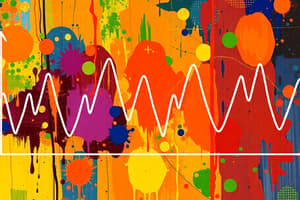Podcast
Questions and Answers
What is the purpose of autocorrelation and partial autocorrelation in time series analysis?
What is the purpose of autocorrelation and partial autocorrelation in time series analysis?
- To determine the significance of independent variables
- To identify patterns, trends, or relationships in the data (correct)
- To analyze the distribution of errors in the model
- To measure the strength of the relationship between two variables
What do autoregressive models use to predict future observations?
What do autoregressive models use to predict future observations?
- Residuals
- Past observations (correct)
- Structural breaks
- Independent variables
What are AIC and BIC used for in time series analysis?
What are AIC and BIC used for in time series analysis?
- To quantify the effect of a change in an independent variable
- To select the best model among a set of candidates (correct)
- To test for stationarity in the data
- To measure the strength of the relationship between two variables
What is the purpose of independent variables in time series analysis?
What is the purpose of independent variables in time series analysis?
What do finite distributed lag models include?
What do finite distributed lag models include?
How can structural breaks in data affect multiple lags of a variable?
How can structural breaks in data affect multiple lags of a variable?
What are interim and total multipliers used for in time series analysis?
What are interim and total multipliers used for in time series analysis?
What do ARDL models combine?
What do ARDL models combine?
What do Granger causality tests examine in time series data?
What do Granger causality tests examine in time series data?
What can non-stationary time series lead to in regression analysis?
What can non-stationary time series lead to in regression analysis?
Flashcards are hidden until you start studying
Study Notes
- Time series analysis examines data to identify patterns, trends, or relationships.
- Autocorrelation and partial autocorrelation are used to analyze time series data.
- Autoregressive models use past observations to predict future observations.
- AIC and BIC are used to select the best model among a set of candidates.
- Independent variables are used to explain or predict the value of a dependent variable.
- Finite distributed lag models include lags of independent variables.
- Structural breaks in data can affect multiple lags of a variable.
- Interim and total multipliers are used to quantify the effect of a change in an independent variable.
- ARDL models combine autoregressive and distributed lag models.
- Long-term effects in ARDL models represent the impact on a dependent variable of a permanent change in an independent variable.
- ARDL model combines autoregressive and distributed lag models.
- Long-term effect of ARDL represents the impact of a permanent change in X on Y.
- Short-term effects in ARDL are less straightforward due to the interaction of lags of Y and X.
- Error correction format can help separate and interpret long-run and short-run effects in ARDL.
- MA model represents the relationship between a variable and past errors or residuals.
- Autocorrelation of MA model abruptly stops after q terms.
- ARMA model combines AR and MA models to capture complex patterns and dependencies.
- Pseudo-out-of-sample forecasting is used to estimate a model's performance.
- Granger causality tests whether lagged values of one variable can help predict another variable.
- Non-stationary time series can lead to spurious regressions and should be transformed using techniques like differencing or detrending.
- ADF test is used to test for stationarity in time series data.
- The number of lags to include in the ADF test depends on the autoregressive order of the time series.
- Detrending and differencing are solutions to non-stationarity.
- Dummy variables are used to model breaks in the data.
- The Chow breakpoint test is used when the breakpoint is known in advance.
- The QLR test is used when the breakpoint is unknown.
- ARCH models are used to model the time-varying volatility in time series data.
- GARCH models are an extension of ARCH models that account for both past errors and past variances in modeling current variance.
- GARCH(p,q) models have autoregressive and moving average components.
- The variance of each observation in an autoregressive conditionally heteroskedastic series is determined by the variance of past observations and the squared residual of past observations.
Studying That Suits You
Use AI to generate personalized quizzes and flashcards to suit your learning preferences.




